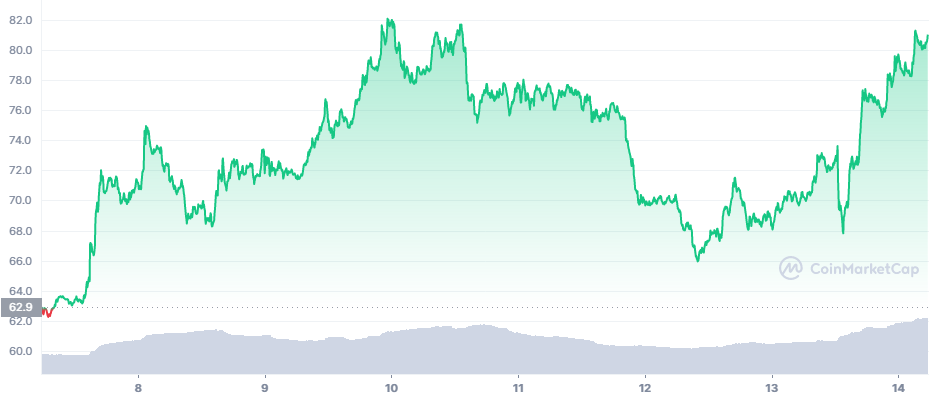Aave (AAVE): Regular Breakouts Take Token Near Monthly Peak

Aave (AAVE) is one of the older DeFi protocols with surprise moves. During the latest rally, AAVE added 14.91% overnight to $80.58, extending the trend of tokens and coins having a successful day despite the BTC stagnation.
The AAVE rally arrived as Bitcoin (BTC) remained volatile, moving between $19,300, later recovering to $20,148.02.
Despite being a decentralized protocol, AAVE is mostly supported by its Binance trading pairs and a Coinbase listing. AAVE had the advantage of relatively early listings, being listed on Kraken as well as the more recently launched FTX, with evenly distributed volumes across exchanges.
Can AAVE Recover Previous Levels
AAVE is a token that peaked during the DeFi season of 2021. The token rose to a peak above $630 in May last year, and has been in freefall since then.
The current valuation under $80 is not unusual for AAVE, though it reflects the effect of the bear market on DeFi protocols. AAVE now holds around $5.3B in notional value, down from $18.5B at the peak. AAVE managed to compete with top DeFi networks, including Solana, BSC, Avalanche. AAVE is now the fourth largest DeFi protocol on Ethereum, though briefly, it competed with Maker DAO.
The actual value held in the protocol also varies based on reporting, with around $4B in value reported on Ethereum. AAVE has been surpassed by UniSwap, Curve Finance and Maker DAO taking the top three spots on Ethereum DeFi.
The fortunes of AAVE still hinge on Ethereum (ETH). The token, used widely as collateral, now hovers just above $1,000, still protecting the DeFi field from some of the worse liquidations.
The bear market, now officially lasting about six months, also saw DeFi hold its own in a much better way. Improved algorithmic trading and automated liquidation protection meant most protocols deflated more gradually. DeFi stalled at around $40B in value locked, down more than 60% from its peak.
The worse effects from the market came from centralized organizations, which held user funds in a way that could not allow immediate withdrawals. DeFi, on the other hand, allowed users to withdraw their funds, even if it led to partial losses.
AAVE is not without its risks, still relying on overall trust in the crypto ecosystem. The protocol also gave rise to Aavegotchi, an NFT staking game. The stability of DeFi protocols still depends on users willing to provide their funds in valuable assets, expecting better returns than centralized exchanges.
AAVE Prepares for Algorithmic Stablecoin
AAVE is now moving into a DeFi approach that has been deemed relatively risky. The protocol wants to use its collateral to create and mint a new type of asset, another stablecoin.
This approach was at the core of the Terra LFG value boom, where LUNA secured the creation of the UST asset. In turn, UST was used to pump the price of LUNA.
Now, AAVE has stated its intentions to produce a new stablecoin, GHO. As with other projects, the chief promise is that GHO would be backed by an over-collateralized reserve. However, the rapid devaluation of crypto assets may mean that even bigger collateral may be inadequate. This does not guarantee the crash of GHO and AAVE, but raises serious concerns of the protocol’s viability in a deeper bear market.
The GHO stablecoin has not been minted yet, and depends on the voting of the AAVE community. The asset, priced at $1 in ideal conditions, will be backed by the already existing AAVE assets.
So far, only some of the experiments with stablecoins have achieved success. The risks include deliberate market attacks, as in the case of NUSD, the WAVES-backed stablecoin. The price of WAVES was simply too volatile to protect the value of NUSD.
An example of a more successful project is TRON’s USDD. The supply of USDD only grows slowly and has tapered off at around $721M. The USDD trajectory is still more careful in comparison to the minting of Terra’s UST.
At the same time, AAVE may rally based on the expectations of higher earnings with the addition of a new stablecoin. But it would make the protocol move vulnerable during a downturn.
Is the Market Bottom Close
The repeated token and altcoin rallies suggest there is still enough exuberance on the markets. There is more talk of the market bottom setting in, with BTC leading the trend. In the past downturns, the crashes were limited to hundreds of dollars, so far avoiding a shift to a lower range.
BTC and crypto assets have also performed relief rallies in the past, while also having a longer-term bear market trend. With BTC still close to $20,000, the current situation is seen as less dire despite liquidations.

Uphold makes buying crypto with popular currencies like USD, EUR and GBP very simple with its convenient options to swap between crypto, fiat, equities, and precious metals.

With over 50 coins and an obsession with security, Kraken is one of the safest places to buy and trade crypto.

Kraken has a good reputation for security and protection of your funds and operates across the USA (except NY), Canada, the EU and Japan

Based in Charleston, South Carolina. Serves over 184 countries and has done over $4 billion in transactions. Offers convenient options to swap between crypto, fiat, equities, and precious metals.

What is cryptocurency? What gives it value? How do you buy and store it? Beginners questions answered in plain English.

The basics of cryptocurrency portfolios and how to get started in tracking your crypto holdings

The leader in programmable money, smart contracts and decentralised applications. There have been many copycats but none have the community and level of adoption.

This is a specific digital coin running on a series of servers. XRP promises utility in handling cross-border transactions to compete with the SWIFT interbank payment system. Being controlled by banks, many question if it is a true cryptocurrency.